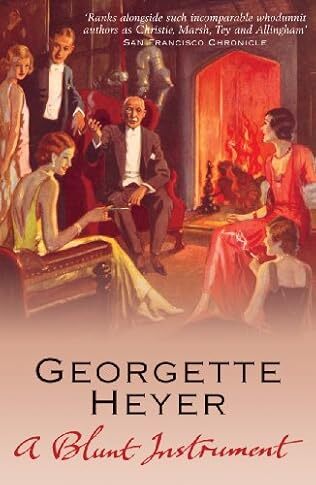A Blunt Instrument

A review of A Blunt Instrument by Georgette Heyer – 250302
This is the fourth and last of Heyer’s Inspector Hannasyde series, originally published in 1938, and is aptly titled. Much of the mystery concerns the identity of and the whereabouts of the murder weapon, a blunt instrument capable of inflicting substantial damage on the crania of two victims but one which is neither found at the scenes of the crime or seen being carried away, and the culprit themselves is a blunt instrument in their own right.
The first victim is Ernest Fletcher who is found in his study by one of the strangest and distinctive policemen in detective fiction, the evangelical, messianic, bible-quoting PC Malachi Glass who happens to be passing on his rounds. There was much toing and froing to Fletcher’s study in the half an hour leading up to the murder, along with some obligatory hiding behind bushes and one clock that tells a slightly different time from the others, and Hannasyde’s problem is compounded by the fact that there are two versions of a murder timeline that do not tally in all their particulars.
There is the version provided by the stalwart police constable whose religious mania suggests that he would have anything but the precise truth and that put forward by and changed by various of Fletcher’s family, including Helen North who has gambling debts she is anxious to hide from her husband and whose IOUs are in Fletcher’s possession, and Fletcher’s nephew and heir, the impecunious Neville Fletcher who has a very flippant attitude to the death and the reasons why he might come under serious suspicion.
It emerges the Ernest, unlikely as the portrayal of his character is, was a bit of a lady’s man and was in the habit of setting up his favourites in comfortable flats. One of these was a showgirl by the name of Angela Angel who when she is eventually let down commits suicide. The second murder victim is Charlie Carpenter who was seen at the scene of Fletcher’s murder, had left fingerprints, and was associated with Angel, a case of a little knowledge being dangerous perhaps. To Hannasyde’s intense annoyance Carpenter’s murder takes place almost in front of his eyes.
Despite Heyer’s best efforts to introduce some whopping red herrings, not least the sudden and unexpected return of Mr North, Helen’s husband, who has curtailed a trip to Berlin, two confessions, and the flippant attitude of Neville, there can only be one credible solution to the mystery of whodunit and what happened to the murder weapon. I find that if the reader, as this one did, cracks the case too early then the rest of the book can tend to pall, although I was a little hazy on the motive other than a general animus against Fletcher. When the surname of Angela Angel is revealed, it all becomes obvious and the twist in the tail was, I am sure, intended to be sensational.
What rescues the book for me is the humour. Hannasyde rather does the dirty on his faithful sidekick, Hemingway, by saddling him with Glass while he, Hannasyde, goes off to explore more fruitful avenues. Glass irritates Hemingway profoundly and their exchanges are a delight to read as are those between the puritanical constable and the frivolous Neville Fletcher, who at least has the intellect to fight back armed with suitable biblical quotations. Hemingway seems astonished at the end as to how the case turns out but with a little thought and analysis of the possible permutations there could only be one culprit.
It would not be a Heyer novel without a romance and while the Norths seem to salvage their marriage, there is an unlikely alliance between the crime writing, monocle-wearing Sally, the only vaguely sensible member of the group and Neville. Each to their own!



